WEDNESDAY
JULY 31 - 2019
Langstone
Mill Pond
Peter
Milinets-Raby reports . . . .
The highlight of this mornings three hours at
Langstone Mill Pond (6:15am to 9:35am - tide out) was
seeing 4 Common Sandpipers together on the pond
outflow stream. Over the last six years I have seen
seven birds in the area before this date, so to get an
impressive multiple occurrence was unprecedented!
Also on the shore were a single Greenshank, 3 summer
plumaged Grey Plover, 24 Black-tailed Godwit (O//R +
WL//-), 2 Dunlin, a Whimbrel and only 30+ Redshank
(-//B + B//NN).
On the pond were 2 female Tufted Ducks with 3 grown up
juveniles, plus 1 Cormorant, 1 Sparrowhawk, 21+ Little
Egrets, 4+ juvenile Black-headed Gulls (see photo) and
3 Swifts over.

Cattle
Egret news
After three
hours of observations of the Cattle Egret colony this
morning, there was very little new knowledge I could
add.
Nest 1: Again, the nest was only visited the once with
the parents swapping over duties. I managed to see a
movement of a chick in the nest today, which just
confirms what I already know, but no numbers yet!
Nest 2: The chicks do wander from this nest, but
return fairly quickly and snuggle together in the
nest. Single adults were seen on three occasions as
they came in to feed
Nest 3: No sightings today, but there again I didn't
see many adults around,
Nest 4: The two chicks climbed to the top of the
Willow Tree on several occasions. An adult visited
twice to feed them.

Nest 5: These three
chicks managed to climb up out of their nest and
wander over to the Grey Heron nest (unoccupied this
morning).
At one point all the chicks from nests 2, 4 & 5
were out on view. At one point I had possibly counted
nine of them, which means one came from somewhere
else? But, seconds later I could only see 8, so I was
left with some doubt! When the adults returned to feed
them they would clamber back to the nest at high
speed. Very amusing!! Only one adult was seen at any
given visit. These chicks were fed quite regularly
(seven visits) and just like on my last visit, one of
the adults after feeding the chicks climbed to the
Grey Herons nest to pinch a stick and bring it back to
nest 5.
Nest 5a: No sightings today.
MONDAY
JULY 29 - 2019
Bumblebee
in garden
I had this
little chap actively collecting pollen from flowers of
Sedum (Kamtschaticum Variegatum) in this
garden this morning. From its red tail and all black
body and I think it must be a Bombus
lapidarius Bumblebee - and a worker judging
from its large orange pollen sacs.

North
Thorney
This afternoon
I had a walk along the track from Thorney Road to the
seawall and down to Little Deeps before coming back
through the old Marina Farm site - now badly
dilapidated. There was an excellent array of wild
flowers along the main track including Stone Parsley,
Yarrow, Teasel, Wild Carrot, Great Willowherb,
Hogweed, Common Knapweed and some sweet smelling
Spearmint. That was a nice surprise.

I was interested to
see Agrimony both in flower and in fruit. The
yellow flowers are arranged in a long spike and the
fruits are small obconical (ie cone pointing
downwards) burs, deeply furrowed and fiercely hooked.
They really do cling on!

There are a couple of
clumps of Golden Samphire in full flower on the
concrete seawall.
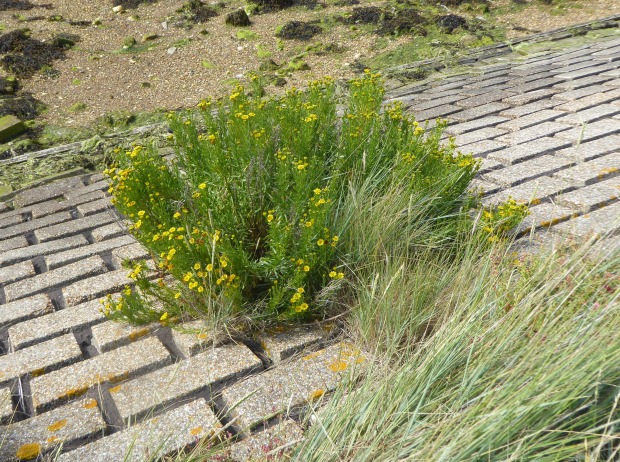
Cattle
Egret news
Peter
Milinets-Raby visited Langstone Mill Pond this
morning. He arrived at 6:15am and stayed until 8:45am.
He spent the time observing the Cattle Egrets and at
the end of the visit, he said there really was not
much more to add to the current situation.
Peter got a
cracking shot of the two stars of the Langstone
Millpond show: Little Egret and Cattle Egret.
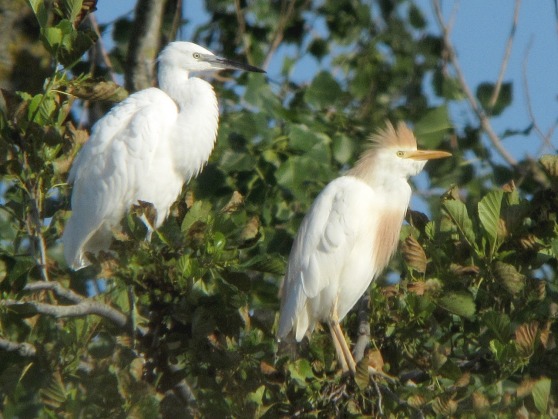
The following is a
short conclusion of his 2.5 hours of observations this
morning.
Nest 1: As per
previous occasions, this nest was only visited the
once during the whole time I was on site and the
adults swapped duties and the sitting bird departed
off east towards Thorney Island within a minute of the
incoming bird. As an adult is continually present on
this nest, the chicks do not to wander. The chicks in
this nest must be roughly the same age as all the
other chicks, but for some reason the adults do not
leave the nest unguarded? The number of young in this
nest is not known.
Nest 2: There is
always an adult on this nest or perched nearby (less
than 2/3 metres away on a favoured perch). When the
adult stands nearby to preen, the three chicks climb
about amongst the foliage wandering 4/5 metres away
from the nest. Two of the chicks were aggressively
wing flapping this morning. Both adult birds were
observed on the nest for a couple of minutes during
one particular change over.
Nest 3: Single adults
on three occasions were seen in and around the area
where this nest is presumed to be located. Alas there
is no solid evidence, except for sightings of adults
"visiting" the area. More observations required.
Hopefully wandering young will be observed soon in the
area.
Nest 4: The nest is no
longer viewable due to foliage covering the nest,
however the two chicks wandered up from the nest to
sit amongst the top branches of the Willow Tree giving
views every now and then. Both birds were observed to
flap their wings frantically. Adult birds were
observed twice visiting the young to feed
them.
Nest 5: The foliage
has fallen again, making this nest not as visible as
it was several days ago, however, the nest structure
is still on show. Two of the three chicks climbed up
the branches on several occasions and joined the
chicks from nest 4 in the top of the Willow Tree. Only
one adult at a time was seen visiting the nest to feed
the chicks. During the first hour of the morning the
adults were flying off west and down to probably the
local stream near to the colony. At 7:31am an adult
was observed feeding the chicks. Afterwards it climbed
up through the foliage and visited the north side of
the Number One Grey Herons nest where it tugged and
pinched a stick. It then climbed back through the
foliage to Nest 5 and weaved it into the fabric of the
nest before it flew off east towards Thorney
Island.
Nest 5a: On a couple
of occasions this morning, I watched an adult climb
its way down through the Willow Tree and stop
immediately behind Nest 5 (a few metres further back
in the thick foliage) where it looked like it was
regurgitating food/feeding young. The views were poor
and inconclusive, but enough to suggest that a nest
may exist immediately behind nest 5. Definitely more
observations required.
Unusually this
morning, during the first 20 minutes I had 5 adult
birds on view at the same time and this occurred just
minutes after two adults flew off strongly towards
Thorney Island. This gave me a reliable count of 7
adults seen this morning, with 8 chicks from 3
nests.
Other birds of note
were great views of a female Tufted Duck with three of
her growing juveniles (see photos),
2+ Reed Warbler, a
Willow Warbler (the first returning bird) and 16+
Little Egrets (with the bird still sat on the nest on
the island). Off shore were 87 Redshank, 16
Black-tailed Godwit, 1 Whimbrel and the family group
of Mute Swan with 5 cygnets.
SUNDAY
JULY 28 - 2019
Brook
Meadow
I went for a
stroll through the meadow this afternoon where I
stopped and chatted to a number of visitors including
one pair who had lived in Emsworth for 40 years, but
had never been on the meadow before! I also stopped
and chatted with Gavin Miller and his niece from
Canada and Dan Mortimer who was carrying out a regular
butterfly transect.
On the wildlife front
I noticed the first ripe Blackberries on a bush
in Palmer's Road Copse. Soon they will be everywhere,
though the early ones are never all that sweet.
Teasel is now flowering with much more to come.
I had a 30 mins vigil
on the river bank in Palmer's Road Copse looking in
vain for Water Voles. I could see several
promising burrow holes, but sadly no actual voles as
yet. Better news came from Westbourne where Sue Wood
saw a Water Vole in the canalised stream near the
church hall. Sightings have been regularly reported
from that site.
I could not find any
Plicate Sweet-grass on the Bramble path where
it has been for many years. What has happened to it?
There's a good crop of Stone Parsley at the
north end of the Bramble path in the south meadow.
I did another count of
Marsh Woundwort which came to an astonishing
116 spikes - well up on yesterday's count and the best
ever on Brook Meadow. The flowers were attractive to
Bumblebees.

A view of the path
towards the Lumley gate lined with tall Hogweed and
large Butterbur leaves.
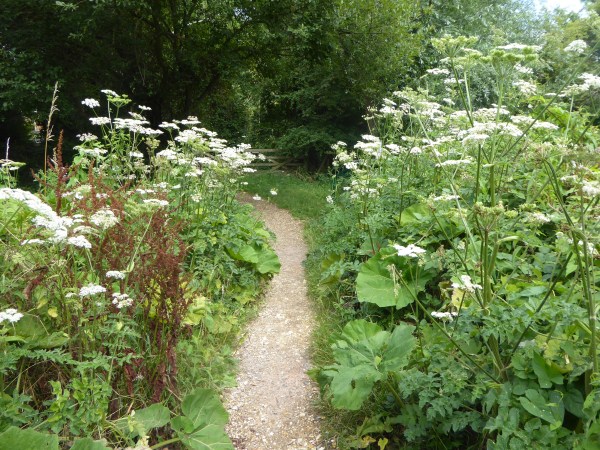
SATURDAY
JULY 27 - 2019
Brook
Meadow
I had a
pleasant stroll through the meadow this afternoon,
refreshing cooler than the past few days after the
morning rain.
Butterflies were
fairly scarce on the meadow this afternoon. Plenty of
Whites and a few Meadow Browns and Gatekeepers, plus
one Red Admiral which did not stop. I am still waiting
for the predicted influx of Painted Ladies which has
not yet occurred, at least down south. But I managed
to get a shot of this Speckled Wood as it came
to rest on a large Butterbur leaf.

I spent some time
examining the insects feeding on the flower heads of
Hogweed. They were mostly Hoverflies, Wasps and
Soldier Beetles, all feeding quite happily together.
Clearly there was no shortage of nectar.
I also spotted the
large and distinctive hoverfly Volucella
pellucens which is a regular on Brook Meadow.
It is quite bulky for a hoverfly with a broad black
and white abdomen. It hovers just above head height.

While I was watching
and taking photos of insects on the Hogweed I spotted
a very tiny brownish moth with yellow spots on its
wings. Here it is with a Syrphus ribesii
hoverfly for a size comparison. A bit of detective
work on the internet led me to Pammene aurana
- aka Orange-spot Piercer.

Flying in June and
July these micro moths can be found in the afternoons
on the flowers of its foodplant - Hogweed. The larvae
spin seeds of Hogweed together and feed on the sees
inside the spinning. It is classified as common and is
widely distributed throughout the British Isles.
Information from www.naturespot.org.uk
I was interested to
see a good crop of acorns and some Knopper
galls on the Oak sapling that I planted on the
Seagull Lane patch in 2012. The Oak that the Mayor
planted on the same occasion does not appear to have
any acorns at all. Also its leaves are much paler
green than those on 'my' tree. Maybe it has a problem,
though it looks healthy enough.

On the flower front
Wild Angelica, Hemp Agrimony and Hoary Ragwort
are starting to open up their flowers.

Square-stalked St
John's-wort is now widespread across the Lumley
area. There is also a patch of Perforate St
John's-wort on the north side of the Lumley area. The
two plants appear similar except for the stems. There
is also lots of Red Bartsia in flower on the Lumley
area.
Pepper-saxifrage is
really struggling on the east side of the Lumley area
against the burgeoning Hemlock Water-dropwort and
Bindweed.
I checked the Marsh Woundwort near the White
Willow at the north end of the south meadow and
counted no less than 74 flowering spikes with more to
come I think. This is certainly the best count I have
ever had of this attractive plant.

Further down the
Bramble path I found the first Water Mint in flower.
FRIDAY
JULY 26 - 2019
Cattle
Egret news
Peter
Milinets-Raby visited Langstone Mill Pond this morning
from 6am to 9:45am - The tide was very sloooowly going
out. Again, the Cattle Egrets took up most of his time
and the following observations were noted.. . .
6:05am: An adult was
perched on the Willow tree above Nest 4 and a second
adult was perched to the right and low down to Nest 2.
Nest 2 looked occupied with an adult bird
sitting.
6:12am: An adult
climbed up through the Willow Tree departing what I
believed at this moment in time to be Nest 4. It was
not until two hours later did I realise that this was
NOT Nest 4. This was the suspected Nest 5 and it
contained three chicks standing tall and huddled
together. Somehow the foliage that had hidden this
nest had moved in the wind and thunder storms of the
last few days and the nest was viewable!
6:19am: Three adults
on view - One with a stick in its bill perched in the
Willow Tree, one visiting Nest 5 and the third was
scrambling about in the trees to the left of Nest
5.
6:28am: An adult flew
off and headed east towards Thorney Island.
6:33am: An adult
appeared low down to the right of Nest 2. A favourite
perch for birds after leaving Nest 3. At 6:35am, this
bird did indeed fly around to where Nest 3 is possibly
located?
6:43am: Adult appeared
and visited Nest 5 to feed chicks. The bird departed
at 6:48am and flew off east towards Thorney
Island.
6:59am: An adult
appeared from the area to the left of Nest 5. It
landed in the nearby Oak where it preened. It looked
like a bird that had just come off a long stint on the
nest. It looked dishevelled and preened before it flew
off east towards Thorney Island at 7:03am.
7:06am: An adult just
appeared (like they do), perched on the nearby Oak and
vanished at 7:13am when I had my back turned counting
Redshank!
7:32am: An adult flew
in from the east and landed on Nest 2. The sitting
adult left at 7:35am and flew off immediately east
towards Thorney Island. The remaining adult
regurgitated its pay load and fed the chicks in the
usual frenzy of wings, necks and beaks! The adult
stepped off the nest to perch about a metre away. The
chicks tried to follow and allowed me to get an
official count and some photos. Three chicks in Nest
2.

This chick in Nest 2
with the wing raised shows an unusual identification
feature ~
ie the pale salmon orange colouration in the under
wings of Cattle Egret. This is not present in Little
Egret young.
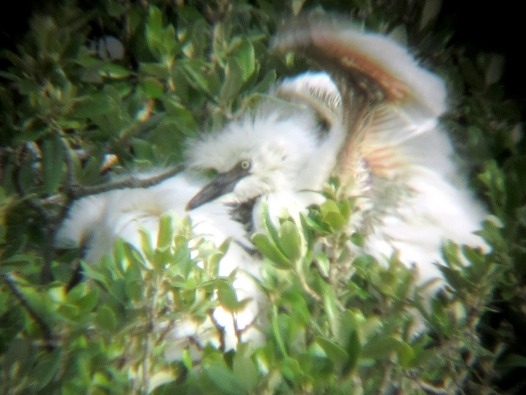
7:37am: An adult flew
in from the east and visited Nest 5 to feed the three
chicks.
7:44am: An adult
(probably Nest 5 bird) departed east to Thorney
Island.
7:58am: The adult bird
from Nest 2 rounded up its offspring and sat back down
on the nest. Nothing visible.
8:35am: An adult's
head could be seen at the Nest 3 location.
8:37am: The adult on
Nest 1 stood up and showed off its mantle.
8:38am: It was at this
point that an adult flew in and visited Nest 4 (95%
obscured by the fallen bough) and the penny dropped as
I could just see two chicks being fed. I checked my
"location" photo on my phone and confirmed the
discovery by chance of Nest 5!

8:43am: Adult appeared
and fed the chicks in Nest 5. The adult on Nest 4 was
still present and luckily in the background through
the foliage I glimpsed another adult in the process of
dramatic head movements reminiscent of regurgitation.
Could this be another nest location?
9:00am: After a three
hour wait an adult flew in from the east and flew
straight into Nest 1 (and out of sight). Within only
seconds an adult departed (probably the sitting bird)
and flew off east towards Thorney Island.
9:09am: Adult feeding
chicks in Nest 5.
9:23am: An adult with
a stick took it down in behind Nest 5.
In conclusion from
this mornings observations. Nest 1 continues to be
visited (but just out of sight), Nest 2 has three
chicks, Nest 4 has two chicks and newly confirmed Nest
5 has three chicks. Nest 3 seems to exists, but is
totally not viewable. It appears that there could be
two further nests behind the main Holm Oak/Willow Tree
colony located either side of Nests 4 & 5. More
observations needed.
The Cattle Egret
chick count this morning was 2 on Nest 1, 2 on
Nest 2, 1 on Nest 4, 1 on Nest 5, 1 on Nest 3 and 1
further behind - total 8 definite adults and 8 chicks.
Other
observations
Other birds of note this morning were a brief view
of a female Tufted Duck with 6 very tiny ducklings
(days old) before she vanished up stream. Also on the
pond were 64 Mallard, the Mute Swan family, a female
Teal, 2+ Reed Warblers,17+ Little Egrets, a
Sparrowhawk, 1 Swallow and 2 Swifts. Off shore
eventually on the exposed mud were 34+ Med Gulls, 3
Black-tailed Godwits, a Whimbrel, 99 Redshank and a
Greenshank.
TUESDAY
JULY 23 - 2019
Brook
Meadow
I had a very
slow walk through the meadow on this baking hot
morning. Before going through the Seagull Lane gate I
had a wander along the path leading to the railway
bridge where I found Knotgrass and sweet smelling
Pineappleweed which I can never resist smelling. Also
along this path some extra large Greater
Plantain caught my eye - with tall flower spikes,
or 'rat's tails' as they are sometimes called.

On the east side of
the meadow, I admired the spikes of the grass Timothy
- now in full flower. What a beautiful grass! Who says
grasses are dull?

Coming back through
Palmer's Road Copse I stopped to look for Water Voles
at the newly reinforced river bank - which is,
incidentally, a very nice spot for observing the
river. There were no voles, but I did spot my first
Common Darter (female) of the year. This is the
best image my basic camera could get of the insect
through a tangle of Pendulous Sedge.

The flowers of
Lesser Burdock are just starting to open at the
start of the riverside walk through Palmer's Road
Copse behind the bins. These flowers are a great
source of nectar and were already being sampled by a
ginger coloured Bumblebee - Bombus
pascuorum (I think).

Hedgehog
The trail
camera caught just one Hedgehog last night prowling
around the patio. Here is a short clip of the male hog
having a good drink from the tray of water I always
leave out for them. Go to . . . https://youtu.be/UV6Vq4veWwk
Peter's
news from Langstone
Peter
Milinets-Raby was accompanied on his walk this morning
by Karen Whishaw (a novice bird watcher on a camping
holiday from Bath - who made contact with Peter via
the HOS website. They had a pleasant two hour walk
from 9:30am It was low tide and baking hot!!! Peter's
report follows . . .
The following birds
were seen. At Warblington cemetery there was a flock
of 60+ Goldfinch feeding in the field to the west of
the cemetery that had been allowed to grow wild and
was full of thistle plants. Also a nearby Elder bush
was also attracting the Goldfinch to feed along with a
pair of Blackcap.
Overhead, were a swirl of Gulls and Starlings catching
flying ants. Most of them were Black-headed, but at
least 6+ were Mediterranean Gulls. In the hedgerow
behind Conigar Point we had a scolding Reed Warbler
along with Wren and Blue Tit.
On the low tide mud at Conigar Point were a resting
group of 70+ Gulls The majority were Black-headed and
amongst them we picked out 6 Lesser Black-backed
Gulls, 1 Great Black-backed Gull, 10+ Herring Gulls,
at least 2 Mediterranean Gulls and a single Common
Gull (the first returning bird). Also on the mud were
4 Shelduck, a few Redshank, 2 Oystercatchers, 2 Curlew
and a Greenshank. Flying east we had 3 Cormorants.
Off Pook Lane on the muddy shore were a feeding flock
of 64 Black-tailed Godwit (a handful of them in winter
plumage) and quartering over the fields behind us were
2 Swallows.
At Langstone Mill Pond we timed our arrival perfectly
and watched an adult Cattle Egret fly into Nest 2 and
feed the chicks. Elsewhere on the pond were 55 eclipse
plumaged Mallard, a female Tufted Duck, only 12+
Little Egrets were seen - a bit windy (including the
adult on the island nest), the three lingering
juvenile Grey Herons in Nest 1, 2 Stock Doves (the
usual Moorhen and Coot) and a very brief Kingfisher
fly by!!!
A pleasant little outing.
White
Storks at Knepp
Christopher
Evans visited the famous Knepp Estate yesterday, the
highlight being 6 White Storks.

Christopher also saw
Fallow Deer. The estate has 3 herds of Longhorn
Cattle, as well as Roe & Red Deer. Another
conservation success are Turtle Doves.

Tony's
holiday snaps
As if White
Storks are not enough, here's something to make one
really envious. Tony Wootton sends a link to his
photos from this spring's camping trip to France and
Spain. Click on the i to get the name of the bird. . .
. https://adobe.ly/2M4KqCV
MONDAY
JULY 22 - 2019
Brook
Meadow
I had a slow
walk through the meadow late afternoon. I counted 42
flower spikes of Marsh Woundwort at the top of
the Bramble path in the south meadow. This is the most
I have ever counted on this site.

Newly flowering were
Common Fleabane (a bit later than last year)
and Spear Thistle (a few days earlier than last
year).
Coming through
Palmer's Road Copse I came across a small tuft of
Giant Fescue - the only place on the Brook
Meadow site that this unusual grass grows. This brings
to 23 the number of grasses recorded on Brook Meadow
this year (so far).

I spotted a large
yellow and black striped fly feeding on Hogweed flower
head. It has a distinctly flat body and wings folded
back. I have tentatively identified it as a Soldierfly
called Banded General (Stratiomys
potamida) which I last recorded on Brook Meadow on
07-July-2015. It is mainly recorded from Southern
England since the late 1970s. Soldierflies are so
called after their striking colouration.

The following video
clip shows the insect hopping from one flower head to
another.
Go to . . . https://youtu.be/4Dy8rnVRif8
Tree
clearance
I happened to
meet Maurice Lillie putting away tools after clearing
up a fallen Crack Willow tree on the east side of the
north meadow. Dan Mortimer provided the following
account of the work:
"The
fallen cracked willow tree by Beryl's seat has now
been cut down and cleared. Many thanks to Maurice,
Terry and Andrew from ABNA tool hire who lent us a
petrol generator free of charge, so I could use my
electric chain saw to do the job in record time. Once
we had worked out how to use the generator and turned
the choke up to increase the revs, it only took a
matter of minutes to complete the task. Good job
done"
Wayside
plants
There is a
magnificent Perennial Sow-thistle in full
flower growing in the gap between the pavement and a
brick wall on the north side of the A259 road through
Emsworth, almost opposite the Surgery car park. You
can't help admiring the sheer tenacity of these
plants.

The grass verge at the
southern end of Church Path has the usual crop of
orange flowers of Fox and Cubs along with
yellow flowers of Common Cat's-ear and the tiny mauve
flowers of Field Madder.

SUNDAY
JULY 21 - 2019
Langstone
Mill Pond
This morning
Peter Milinets-Raby was out down Langstone Mill Pond
for sunrise at 5:15am He stayed for over three hours
and watched the tide go out. Here is Peter's pre-dawn
photo of the Mill.

The birding highlights
were as follows:
On the pond were 2 female Tufted Ducks, a Sparrowhawk,
2+ Reed Warblers (still occasionally singing), the
Mute Swan family with 5 growing cygnets, a female Teal
(an early return?), 7 Swifts over along with a House
Martin and 3 Swallows. There were 26 Little Egrets
still lingering in the trees, plus the sitting bird on
its nest on the island (see photo).

Off shore as the tide
dropped were 11 Little Egrets, 50+ Redshank, 9
Black-tailed Godwit (one with colour rings L//R +
WL//-), a flock of 11 Cormorants flew east, 4 Common
Tern, 1 Sandwich Tern and 3 Med Gulls.
Cattle
Egrets
The Cattle
Egrets took up all Peter's time this morning. Below is
a summary of this mornings events:
5:15am: Nothing really showing - with an effort I
could just about make out white blobs on Nests 2 &
4.
5:25am: An adult flew off from somewhere and headed
east to Thorney Island.
5:27am: Another adult appeared in the air from nowhere
and flew off towards Thorney Island.
5:50am: Two of the three Grey Heron juveniles wandered
off their nest and clambered through the Willow
foliage straight passed Nest 4. The Cattle Egret on
Nest 4 screeched alarmingly, raised its wings and
chased the two Grey Herons away. The adult then
stood/rested/preened off the nest and the two chicks
tried to clamber up through the foliage to reach the
adult. When they did, the adult guided them back to
the nest.

7:07am: An adult flew
in from the east and landed on Nest 2. Two chicks seen
- see photos
7:08am: What was
probably the sitting adult on Nest 2 departed the nest
and perched on the nearby Oak tree to have a quick
preen and flew off east towards Thorney Island at
7:11am.
7:27am: An adult flew in from the east and landed in
the other Holm Oak for a minute, then it flew over the
back of the main Holm Oak to disappear (possibly
visiting Nest 3).
7:29am: An adult in faded "Nuptial" plumage emerged
from around and behind the main Holm Oak (possibly
from Nest 3) and perched to preen for the next 20
minutes. It vanished when my back was
turned.

7:48am: The adult on
Nest 4 climbed out of the nest, perched for a minute
to preen, then flew off east towards Thorney Island -
leaving the nest unguarded.

8:03am: The head of
the adult on Nest 1 briefly seen!
8:10am: An adult flew in from the east and landed in
the Willow Tree above Nest 4 and then with a
controlled tumble fell into the foliage and below Nest
4 and out of sight to where Nest 5 is suspected to be
located.
8:11am: An adult flew in from the east and flew
straight into Nest 1 and straight out of sight.
8:12am: An adult flew out from Nest 1 (probably
swapping over) and perched in the Willow Tree and
preened before it flew off east at 8:15am
8:30am: The "Nuptial" adult reappeared in the Willow
Tree by Nest 4 after being "missing" fro 40
minutes.
8:35am: An adult flew in from the east and flew
straight to Nest 4. The "Nuptial" adult joined this
bird. Now this is not a pair, the "Nuptial" adult
obviously has dealings with Nest 3 as well as Nest
4??
In conclusion from
this morning's observations Nests 1, 2 and 4 are up
and running and have adults visiting the nests to feed
young. A fourth nest certainly exists beyond and
behind the main Holm Oak in the rough location of
where Nest 3 was pinpointed in early June. I had my
doubts about Nest 5, but it seems that a nest does
exist in this area. More observation required. I think
Nest location 6 was only the "Nuptial" bird displaying
for a week and not getting any takers and Nest 7
(observed mating and pseudo sitting was just that!).
So, today I observed both birds from Nests 1 and 2,
certainly one adult from Nest 4 (possibly two), an
adult visiting nest 5 and a "Nuptial" plumaged bird
visiting Nest 3 and Nest 4. Seven adults minimum in
total, with the possibility of two others seen and two
chicks each observed in Nests 2 and 4.
Greenfinches
Almost as
newsworthy as Cattle Egrets, Sue Thomas had a family
of Greenfinches in her Westbourne garden today, two
adults and two young. Here they are on one of Sue's
homemade feeders.

It has been over a
year since I last saw a Greenfinch in my garden and to
think they used to be my number one bird, eating
sunflower hearts by the bucketful! They were badly
affected by the disease trichomonosis in 2006 and
never recovered. The following chart clearly shows
their dramatic decline in my garden over the years.
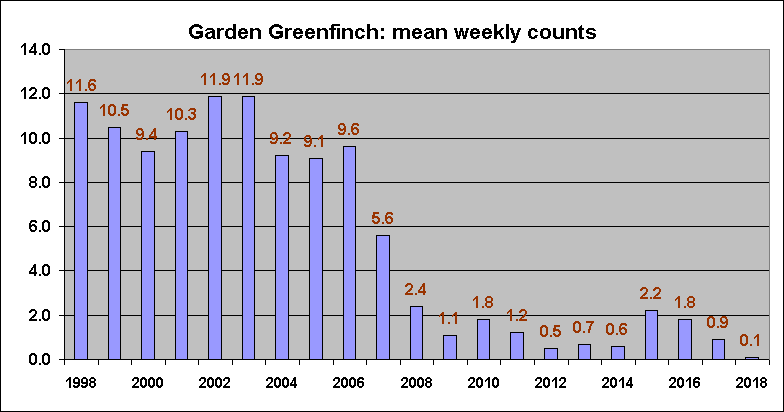
The same thing appears
to have hit Chaffinches which are almost as rare in my
garden as Greenfinches. I have not seen a Chaffinch
for over 6 months. The following chart shows a similar
pattern of decline in Chaffinch garden sightings,
though they were never as numerous as the
Greenfinches.
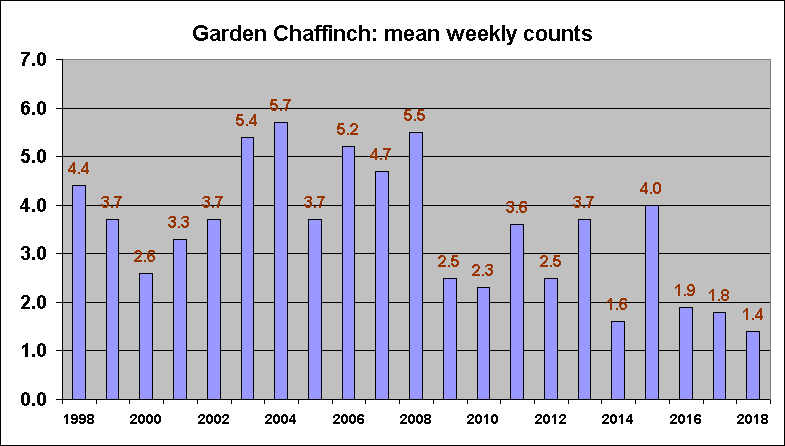
THURSDAY
JULY 19 - 2019
Brook
Meadow
I went over to
the meadow at 9.30 this morning for the regular third
Thursday in the month work session. There was a good
turn out of 12 volunteers despite the rain, led by
Colin Brotherston. Neill Foster attended for the first
time.

The main jobs were to
remove the twiggy barrier around the orchid area, trim
back the paths, cut back the bushes near the Lumley
gate in preparation for Martin Cull who will be coming
in the next week plus litter picking and cleaning of
signcases.

It was good to meet up
with Andy Skeet who was doing his final tree survey on
Brook Meadow. Andy, who has been a good friend of
Brook Meadow since its formation in Year 2000, is
leaving HBC after 31 years as arborist. He will be
working with the East Hants Council. Andy said how he
much he appreciated working with groups like ours
which has opened his eyes to the ecological value of
good tree management. Thanks for everything, Andy and
all the best for the future. Here is a group photo
with Andy in the orange jacket (and me standing beside
him) taken just after our coffee break.

The full report
together with more photos can be seen on the Brook
Meadow web site
Go to . . . https://www.brookmeadow.org.uk/conservation-news/
Wildlife
observations
A Song Thrush
is still singing strongly from the west bank of the
river near the S-bend. A Moorhen family with at least
one chick was on the river near the S-bend. I did not
get the chick in the photo.

Blue Water-speedwell
and Purple Loosestrife are both now in flower on the
River Ems south of the north bridge.
Berries are forming on
the Alder Buckthorns along the main causeway.
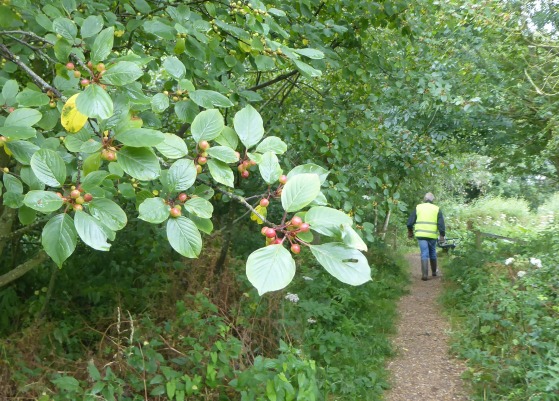
Red Soldier Beetles
are enjoying the large rounded flower heads of Wild
Angelica on the Lumley area.

Water
Vole survey
Dan Mortimer
passed on the report and photos of yesterday's Water
Vole survey on the River Ems on Brook Meadow which was
carried out by Sarah Hughes (Community Wildlife
Officer for Chichester District Council) assisted by
Dan, Terry Lay and Maurice Lillie. A good number of
Water Vole signs were discovered in the area between
the south bridge to the S-bend of the river, but none
further north. The signs included burrows, latrines
and footprints, but no food larders.
Here is a map of
the area from the south bridge at the bottom to the
S-bend at the top
showing the locations of burrows (black dots) and
laterines (green dots)
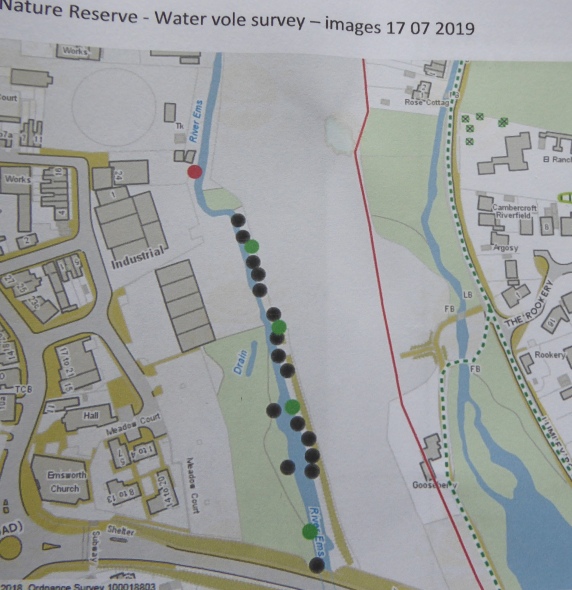
Water
Vole burrow and laterine
They did not actually
see any Water Voles during the survey, but the
findings are very promising. So, I ask everyone to
keep a special look out for any Water Voles, though
the river and banks are not very easy to see at
present from the footpaths.
Red
Kites
Yesterday, Ann
Moodie saw a pair of Red Kites flying over her house
on the Westbourne /Emsworth border. By the time Ann
had rushed inside to get her camera, they had flown
too far away. What an exciting sighting. Red Kites are
occasionally seen over our local area, though to see
two at one time is, in my experience, unprecedented.
Langstone
Mill Pond
Peter
Milinets-Raby I visited Langstone Mill Pond this
morning just as the fine drizzle started to clear (9am
to 10:24am) - It was low tide, slowly coming in.
Off shore there was a fine selection of waders with 2
Dunlin, 1 Greenshank, 1 Whimbrel, 52 Black-tailed
Godwits (Colour ringed bird L//R + WL//- Only the
third sighting of this bird, the first was in December
2011) and 107 Redshank (three colour rings -//B +
B//NW - seen once before in March 2015: -//B + B///YL
- A couple of records from 2015 and 2017: -//B + B//RB
- seen once before in July 2017).
Also off shore were the Mute Swan family with five
growing cygnets.
On the pond were 2 Med Gulls, 1+ Reed Warbler, 1 Stock
Dove, 1 Swift and 20+ Little Egrets. Juvenile Little
Egrets were actively flying around and I was lucky to
get a couple of photos as one bird perched close, plus
the pair on the island were watched swapping over
sitting duties.
Cattle Egrets - Not
much happening this morning. I had poor views of
adults stood on nests 2 and 4 (Nest 2 with one chick -
restricted viewing, so could easily be more Nest 4
seems to have only two growing chicks - again viewing
terrible!). Then, later from nowhere, two adults
departed the pond and headed towards Thorney Island
and they were not the adults on nest 2 and
4?
WEDNESDAY
JULY 18 - 2019
Cattle
Egret nesting spreads
Thanks to the
sterling efforts of Peter Milinets-Raby the successful
breeding of Cattle Egrets has been confirmed for the
first time in Hampshire at Langstone Mill Pond. Now
Birdguides reports that Cattle Egrets have also bred
for the first time this year in Essex and
Northamptonshire. Previously the species only bred in
Cheshire and Somerset. So, with 5 countries now
involved this was the most successful breeding season
ever for Cattle Egrets in the UK. So the seemingly
inevitable colonisation of this country by this
species continues to grow, in a similar fashion to
that of Little Egrets in the 1990s. Soon we shall be
seeing them everywhere!
Here's one taken
this year at Langstone Mill Pond by Peter
Milinets-Raby

For the Birdguides
report go to . . . https://www.birdguides.com/news/western-cattle-egret-nests-in-three-new-counties/
PS Thanks to John
Arnott for the Birdguides link.
TUESDAY
JULY 17 - 2019
Hermitage
Millponds
There was no
sign of the Great Black-backed Gulls on Slipper
Millpond. The youngsters have now fledged but will
return to the pond from time to time. There is quite a
few more Moth Mullein plants coming up in the south
side of Peter Pond and on the island. I took a shot of
the flowering Common Ragwort on th south side of Peter
Pond with Gooseberry Cottage in the background.

The first Spear
Thistle is in flower on the bank. Cinnabar
caterpillars were busy feeding on the Hoary
Ragwort on the path towards Gooseberry
Cottage.
Brook
Meadow
It was good to
see several spikes of the relatively rare Marsh
Woundwort now in flower in the usual place at the
north end of the Bramble path in the south meadow -
just south of the large Weeping Willow. There are more
to come.

Hemlock Water-dropwort
is encroaching on the Pepper-saxifrage plants which
are just starting to show on the east side of the
Lumley area. The group has plans to dig out the
Hemlock Water-dropwort before it takes over any more
of this valuable area.
I saw lots of
butterflies while walking round the Lumley area,
including Gatekeeper and a beautiful
Peacock.
A female Beautiful
Demoiselle also paused for a photo.
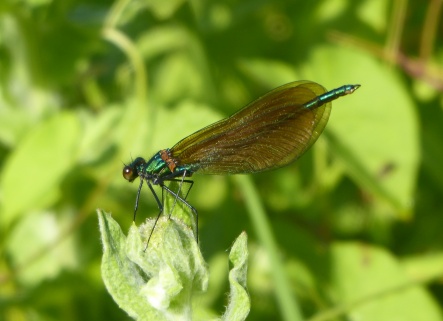
At the Seagull Lane
gate I met up with Lee and Malcolm from Norse
preparing to replace a rotted post in the handrail by
the steps down to the meadow.

Students from Glenwood
School helped today to fill in the gap in the river
bank in Palmer's Road Copse with gravel. Well done
chaps!

Langstone
Mill Pond
Peter
Milinets-Raby visited Langstone Mill Pond this morning
for just an hour from 9am. The tide was coming in.
Off shore were the family of Mute Swans with 5
cygnets, 2 Greenshank, 26+ Redshank and 2 Black-tailed
Godwits.
On the pond were 56 Mallard all fast acquiring eclipse
plumage, along with a female Tufted Duck.
I counted 27 Little Egrets, including the adult
sitting tight on its new nest on the island.
There was only one "whole" Cattle Egret on view, an
adult preening in the Willow Tree to the left of Nest
4. Nest 4 is now virtually not viewable (A bough has
dropped and blocked the view), only a tenth of an
adult could be seen through the foliage on the
nest.
The top bit of the head of a preening adult could be
seen on Nest 2 as it stood and in the little quarter
of the nest that is viewable there was a tiny chick
panting away in the hot sun! And, that's all I could
see today, not very exciting!
For
earlier entries go to . . . July
1-16